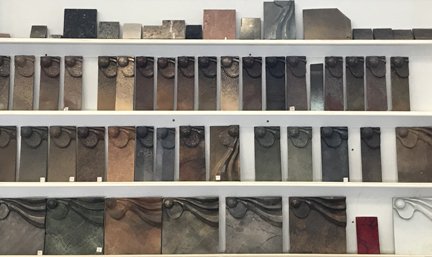FMD #52
Now that the bronze is finished and chased it’s time to apply the patina. You’ve seen that the original state of bronze is yellow/gold…patina is basically a chemical reaction to that metal that occurs over time. The metal reacts with atmospheric acids in the air and rain water or the acids or alkali in soils. The result is a gradual darkening of the metal to rich browns followed by blooms of blue or greens if the right conditions exist. Today the process of patina is controlled in order to get the desired color and effect and then the process is stopped and sealed with lacquer and wax to preserve the look. The first step is to visit the foundry (or the patina artist’s studio) and review the patinas on bronze samples. The samples should have both smooth and textured areas to give a true example of the patina. One thing to bear in mind is that patinas, by their very nature, are organic and subject to change. The temperature of the metal, the strength of the solutions and the very atmospheric conditions of the room will effect the patina and no two are ever exactly alike. Close, yes….but not an exact replica. To expect that to be the case would be to rob the experience of artistry by reducing it to a computer science. It’s organic folks….enjoy the ride!
The Committee and I have chosen to go with a very traditional French Brown patina and the first stop is to the sandblasting booth. Ed cleans the surface of the metal using a fine grit to be sure that all trace oils from hands or any other surface contaminates are removed and the metal is given a slight tooth and grain to better accept the chemicals.
The freshly blasted sculpture is removed and taken to the patina room - notice the use of gloves. The sculpture is not hot, but the oils from bare hands would recontaminate the surface so care is taken to protect the freshly cleaned metal.
The patina is created in the patina room - where special equipment and safety apparatuses and a closed environment can control the sprays and fumes. First stop is the acid wash sink where liver of sulfur is to be applied to the cold metal by spraying on, letting the chemicals react with the bronze and darken the metal to a near black color. This happens in a matter of minutes and a wash of fresh water stops the process. As this is a sulfur solution it does have the lovely aroma of rotten eggs.
The chemicals used in patinas are often corrosive and harmful and are stored in special cabinets. The patina artist wears protective clothing including special gloves, respirators, eye glasses, coveralls and aprons and even cover their hair. These artisans are specially trained and patina work requires specific equipment and skills.
Here is the patina room setup. The large vent hood removes toxic fumes while the artist is working and tanks are for the torches used to heat the metal to the open the pores. This ensures the metal accepts the color and retains the chemical bond for durability. There are a lot of different chemicals and combinations in order to create the varied hues and patterns of bronze patina and for more detailed information you should look into the book by Patrick Kipper:
After the liver of sulfur is applied and some of the dark rubbed off with ScotchBrite pads to create lighter areas and highlights the bronze is heated with torches and then layers of Ferric Nitrate are applied. The metal is heated with torches and the chemicals are applied by brush, by squirt bottles or by airbrush. The bronze is placed on special patina tables that let the excess chemicals run off and are able to withstand both the heat and the chemicals. You’ll see in the video clips that the artist wears protective wear when applying certain chemicals but can remove them for other phases that are not toxic. Safety first!
The first step is the darkening of the surface of the metal by spraying liver of sulfur on the cold bronze.
The liver of sulfur has been applied and then some of the surface brushed back and highlighted using a scothbrite pad, the metal is now being heating up to open the pores and prepare the metal for the application of the ferric nitrate solution.
Ferric Nitrate sprayed on in layers and heat bonded and reacting with the surface of the metal gives the bronze its characteristic rich and traditional French Brown Patina.








